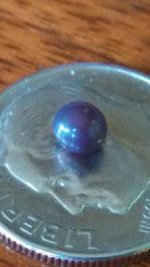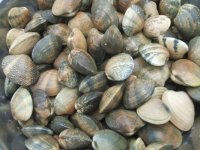Any pearls from Manilla clams are exeedingly rare.
As I'm sure you are aware, this clam (Venerupis phillipinarium) is considered an invasive species. They hitchiked on Japanese Oysters when they were introduced to the North Pacific at Ladysmith BC in the late 1920's. Not all invaders are considered detrimental though, afterall these clams found their own niche and cause no harm to other clam populations. These hardy creatures are highly resistant to disease or parasites and less vulnerable to freezing during big low tides in winter. This is why they live higher along the tideline and shallower with the substrate.
Here in Canada, I farmed Manillas several years ago and harvested tonnes and tonnes from from wild stocks. I pay keen attention to every pearl producing mollusk in the region. Even though I've found thousands in mussels, several in oysters and a few other species, I have yet to find a decent pearl from a Manilla clam. I don't know how many I've personally eaten myself or with others, but suffice it to say it's in the millions. Not only is yours nicely structured and formed, it also presents with a deep purple hue, typical to the color at the outer margins of the shell.
Google pearls from quahogs (Mercinaria mercinaria) They are generally more common than we know, hence reflected in value which is high or low, depending on who you talk to. Google pearls from Manillas, you won't have much luck.
This pearl's value is added because of the rarity. Collectors of rare pearls are just as rare these days, but someone might be intrigued, knowing a pearl from this species has been discovered.
Congratulations to you and your family for a terrific find.







